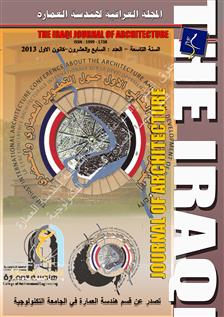Sound environment of Cities
Abstract
The sound environment in the Traditional Baghdad city specified with sound
elements and relationships between sounds that define human sound environment, and
had the greatest impact where natural sounds as human voice, animal and natural sound
in addition to the voices of the traditional industries and the old means of transportation.
The Recent changes in the traditional urban fabric that accompanied with the
requirements of contemporary life. Of transportation, machinery and various industries
affected in the structure of the traditional Baghdad urban fabric and Incision straight
roads to the movement of vehicles and concentration height buildings on both sides of
these roads, with the changing pattern of use of residential to commercial, affected on
the sound environmental and on perceptional preference for the traditional city .For this
reason, An analytical methods and questionnaire studies were conducted in several areas
in Al-Kadhimiya city as an example of the traditional cities. The areas included a wide
range of sound types and different sound level, from highly traffic-noise in Akkad
Street to quiet Al-zuqaq (traditional street).Consistent relationships were found between
measured overall sound levels and perceived sound quality, however, sound source
identification was found to be a stronger predictor of sound quality than measured
sound levels. Sound quality was negatively related to presence of technological sounds
(e.g., road-traffic noise, gasoline generators) in modern type of City Street and
positively related to presence of nature sounds in traditional street.
Downloads
You are free to use the work, but you have to attribute (refer to) the work in the manner specified by the author or licensor (but not in any way that suggests that they endorse you or your use of the work).
IRAQI J. ARCHIT & PLANN grants you the right to publish the metadata of the journal, it's issues and articles under the terms of the Creative Commons Attribution-ShareAlike 4.0 International License.
Author(s) hold the copyright of their aricles without restrictions. However, IRAQI J. ARCHIT & PLANN holds publishing rights for articles and their revisions once the article is published.
Authors can archive pre-prints (ie pre-refereeing) and post-prints (i.e. final draft post-refereeing) versions of the work they submitted to IRAQI J. ARCHIT & PLANN using non-for-profit open-access servers whether on author's personal website and/or institutional repositories including the university or research center where the author work.. For post-prints, only the IRAQI J. ARCHIT & PLANN’s as-published PDF version is permitted and the published source (IRAQI J. ARCHIT & PLANN’s website) must be clearly acknowledged within the archiving webpage.






